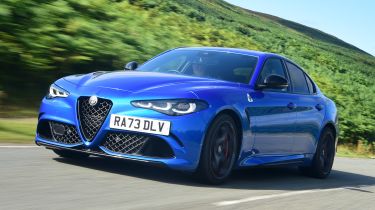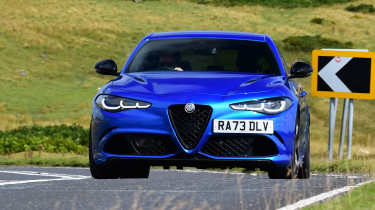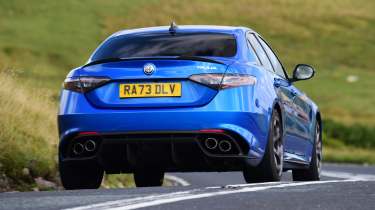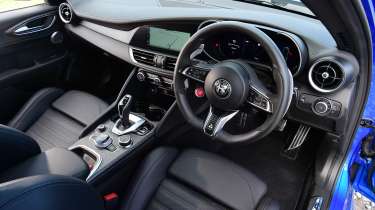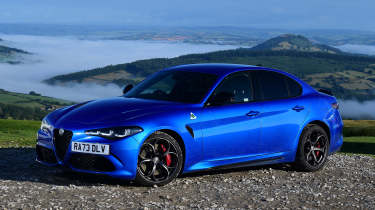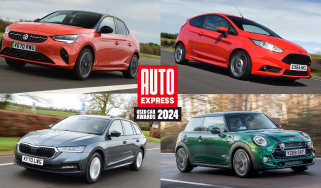Alfa Romeo Giulia Quadrifoglio review
Minor tweaks mean the Alfa Romeo Giulia Quadrifoglio is still a strong competitor in the performance-car market

Is the Alfa Romeo Giulia Quadrifoglio a good car?
When the Alfa Romeo Giulia Quadrifoglio was launched in 2015, it proved to be a stunning return to form for the Italian sports car maker.
For so long, the company had produced achingly pretty cars that couldn’t quite live with the best premium German competition in terms of all-round ability. But here was a model that, when it came to ride, handling, performance and much more, could at least match its rivals, and, in some cases, beat them.
Challengers such as the BMW M3 and Mercedes-AMG C 63 have been updated in the ensuing years, though, and while the latest C 63’s PHEV powertrain has seen it take a backward step in some ways, the M3 has grown even more focused and staggeringly capable.
However, this has only served to highlight the Alfa’s unique personality even more; thanks to a selection of updates for 2024, it means that the reasons to buy it are as compelling as ever – as long as you’re willing to settle for one or two compromises.
|
Key specs | |
|
Fuel type |
Petrol |
|
Body style |
Four-door saloon |
|
Powertrain |
2.9-litre twin-turbocharged V6, rear-wheel drive |
|
Safety |
N/A |
|
Warranty |
3yrs/unlimited miles |
How much does the Alfa Romeo Giulia Quadrifoglio cost?
The Alfa Romeo Giulia executive saloon follows a similar format to cars such as the BMW 3 Series and Mercedes C-Class. There’s a line-up of relatively conventional models (albeit a lot narrower than its two rivals mentioned here) while a range-topping halo model delivers plenty of performance and driving thrills.
More reviews
Car group tests
- Hyundai Ioniq 5 N vs Alfa Romeo Giulia Quadrifoglio: is EV or petrol more exciting?
- The best long-term car tests 2022
In-depth reviews
Long-term tests
Road tests
In fact, the Alfa Romeo Giulia Quadrifoglio (four-leaf clover in Italian) was the car that launched the company’s four-door saloon back in 2015, ahead of the rest of the range. And it was launched to rave reviews back then, while minor updates throughout the years have helped it retain appeal with driving enthusiasts.
Prices have risen over time, especially with the launch of limited-run GTA and GTAm editions, with the car gradually creeping closer to the £80,000 mark. But for a lot of buyers it’s a car that’s worth every penny, thanks to its punchy 513bhp 2.9-litre twin-turbo V6, the sublime balance between handling and comfort, and stylish looks that still manage to turn heads.
Engines, performance & drive
There are two changes for the updated Alfa Romeo Giulia Quadrifoglio that hone an already compelling package. The first is only minor, with the 2.9-litre V6 engine gaining a modest power bump, courtesy of a revised engine-management system, to produce a maximum of 513bhp, an increase of 10bhp.
That difference is hard to appreciate on the road when so much power was already on tap, and there’s no change against the clock, because the 0-62mph time of 3.9 seconds is the same as it was previously. That maximum 513bhp power output is backed up by 600Nm of torque that arrives from 2,500rpm.
More significant is the introduction of a mechanical limited-slip differential. The old electronically controlled diff had a tendency to deliver inconsistent feedback, which meant that not only would power often be wasted by spinning the inside rear wheel on corner exit, but the differential would also be prone to overheating during hard track driving.
The Giulia Quadrifoglio has a range of weight-saving measures. The engine has an aluminium block, while carbon fibre is used for the prop shaft, bonnet and side skirts. As a result, the car tips the scales at 1,660kg, which is light when compared with cars of similar performance, such as the plug-in hybrid Mercedes-AMG C 63 and the all electric Hyundai Ioniq 5 N, which is nearly 600kg heavier. Granted, the Hyundai has four-wheel drive and the Alfa doesn’t, but the difference is still a key advantage that the Giulia is able to exploit.
One thing that is often overlooked in modern performance cars is ride comfort. Not the Giulia, however; while its adaptive dampers are firm in the sportier of its two modes, there’s still a feeling of suppleness that is missing in rivals.
Switch the dampers into their softest mode – available as a default setting in the ‘N’ position of its DNA switch, although it can be selected in Dynamic mode, too – and the whole car seems to breathe out and relax its muscles; all of a sudden it flows with the road beautifully. This pliancy doesn’t just work in everyday driving, either. Find a more challenging section of road, and the Alfa flows along an uneven surface rather than pounding it into submission, as is the case with so many performance-car rivals.
But the Quadrifoglio’s chassis is more than up to delivering thrills, too. Grip levels are enormous, but reach the Giulia’s limits and a fabulous balance, courtesy of its 50:50 weight distribution, reveals itself. Whether the front or the rear loses grip first is entirely at the mercy of your steering and throttle inputs.
The mechanical differential really helps here, too, giving a level of consistency when powering out of corners which was lacking previously. It means that even in Race mode, you can get on the power and be confident that if some level of slip does introduce itself, the car isn’t going to bite.
Not only that, but the differential enables a superb mix of agility and stability when entering a corner. That’s needed, because the Quadrifoglio has typically Alfa Romeo sharp steering. It takes a short time to dial into its responses – especially as we would prefer a little more feedback – but once you learn to trust that the car can live with that responsiveness, it’s incredibly satisfying.
|
Model |
Power |
0-62mph |
Top speed |
|
Giulia Quadrifoglio |
513bhp |
3.9 secs |
191mph |
Then there’s the performance, which is mindblowing in its own right. Throttle response is fantastic and the eight-speed auto transmission snaps into the next ratio quickly, if not quite as instantaneously as a BMW M3’s gearbox. When you’re just cruising around, the eight-speed gearbox is fairly smooth, while the powerful V6 engine does its best to make low-speed driving as relaxing as possible.
As a spiritual successor to Alfa Romeo’s gloriously tuneful Busso V6, there was always going to be a high standard for the 2.9-litre twin-turbo V6 to live up to in the sound department. It’s more businesslike than musical, with a deep growl punctuated by cracks as each upshift is engaged. An optional Akrapovic exhaust adds more volume but not much more personality.
Fortunately, for a car that tops out at 191mph, the brakes feel more than up to the task. We’d choose the steel items over the optional carbon-ceramic discs, because on the road you’ll notice little difference, and save yourself around £6,000. The braking feel isn’t the most consistent with either set-up, but the optional carbon-ceramic set-up can feel more grabby than the standard steel version. There’s no denying that they’re both more than up to the task of hauling the Giulia to a halt.
It’s not surprising to find a car with such wide wheels and low profile tyres to generate a lot of road noise, but the Giulia is still reasonably refined at speed. Combined with its power, stability (something aided by the active aerodynamics from the front splitter) and comfort, it’s an excellent continent crusher.
Despite these small flaws, the Giulia feels superbly set up as a road car. A BMW M3 will blow it away on a track, but on public roads the Alfa is more enjoyable than its German competitor more of the time.
MPG, emissions & running costs
Official WLTP figures state that the Giulia Quadrifoglio will achieve 28mpg. During our time running a pre-updated model on our test fleet, we averaged 25.3mpg. That’s a reasonable return considering the performance on offer. You do get engine start-stop, plus cylinder deactivation on light throttle loads, but you should expect to make regular stops to fill the 58-litre fuel tank on longer trips.
A high purchase price and 229g/km CO2 emissions mean the Giulia Quadrifoglio is lumbered with a sizeable first-year car tax rate bill. From the second year onwards, you’ll be paying a surcharge over the annual VED charge for the following four years due to the Giulia QF costing nearly double the £40,000 threshold. Watch out if you’re thinking of running one as a company car, too, because it sits in the highest 37 per cent Benefit-in-Kind (BIK) tax band.
|
Model |
MPG |
CO2 |
Insurance group |
|
Giulia Quadrifoglio |
28.0mpg |
229g/km |
44 |
One of the consequences of running a high-performance executive saloon with Porsche 911-rivalling performance is the hit you’ll have to take on insurance. The Giulia Quadrifoglio comes in at a very high group 44 – three places higher than the non-Competition BMW M3.
The Giulia Quadrifoglio is predicted to hold on to 45 per cent of its value after three years. That’s slightly worse than rivals such as the BMW M3 and Audi RS 4 Avant.
Design, interior & technology
The distinctive Alfa Romeo Giulia exterior shape is suitably pumped up for the Quadrifoglio. The wide body sits squat on its 19-inch wheels, while a deep front air dam, a subtle spoiler and four fat tailpipes set it apart from the rest of the range at the back.
Among the small changes for 2024 are headlights with revised internals. The daytime running lights sit in a 3+3 arrangement that make a nod to previous Alfas, such as the Alfa Romeo SZ and Alfa Romeo Brera, while LED-matrix tech means that they’re brighter than ever, yet able to adapt their beam pattern to prevent dazzling oncoming traffic.
Inside, there are small changes to some of the materials used, but it’s essentially the same basic layout from 2015. It’s starting to look a little dated compared with the Alfa’s most modern rivals, but the basic controls are all fairly sensibly laid out. If we’re being picky, then the overall cabin quality isn’t up to the standards of similarly priced performance saloons. But what the Giulia gets very right are the details that you touch most frequently.
Take the gearshift paddles behind the steering wheel, for example. Not only do the large metal levers feel much posher than the plastic items that so many other manufacturers use, but the shift action itself has a satisfying click that is rarely felt outside of exotica produced by Ferrari or McLaren.
The firm and slim steering wheel feels better to hold than the thick and squidgy wheel that takes the shine off a BMW M3’s steering. At £3,250, the Sparco Carbonshell front seats are a pricey extra, but they are superbly supportive and look fantastic. The £1,100 Driver Assistance pack is also worth considering if you drive many motorway miles.
Sat-nav, stereo and infotainment
The main change inside for 2024 comes ahead of the driver, where a digital instrument cluster replaces the old analogue dials. But Alfa has kept a very similar layout and fonts within the deeply cowled binnacle, so it has maintained much of the existing character while introducing a little more scope for customisation.
Better still, physical climate controls remain, and there are big dials for the audio volume control and drive modes, too.
The Quadrifoglio’s Alfa Connect 3D navigation 8.8-inch touchscreen isn’t as sharp as the latest systems found in rivals, and its responses are often downright laggy. And unlike some performance-focused rivals, it doesn’t have many in-depth performance menus, although we’d argue that it doesn’t need them, because there aren’t many settings to be adjusted.
The Performance menu can show turbo boost, torque and oil pressure, though, while a physical dial can also be used to make small adjustments to the system on the move.
Boot space, comfort & practicality
The Giulia’s interior and boot space are fairly standard for a four-door compact executive saloon. Some competitors - such as the Audi RS4 and BMW M3 - are available in a more practical estate bodystyle, which is not an option with the Alfa Romeo.
The driving position is fantastic, helped in no small part by the sculpted standard seats. The optional Sparco carbon fibre-shelled sports seats are even better, though. Not only do they look gorgeous, but are as supportive as they are comfortable.
Kneeroom in the back seats is decent for a car in the class, but the sloping roofline means that headroom is a little tight for taller passengers. A wide transmission tunnel, plus a centre seat that is high, narrow and a little firm means that it’s not that comfortable for three passengers.
At 480 litres, the Giulia’s boot capacity is identical to that of a BMW 3 Series and the Ioniq 5 N. The opening is a little smaller and narrower than the BMW’s, though. You can expand the available luggage room by utilising the handy 40/20/40 split folding rear seats. It won’t be as versatile as the Audi RS 4 Avant or BMW M3 Touring estates, though.
|
Dimensions | |
|
Length |
4,639mm |
|
Width |
1,860mm |
|
Height |
1,433mm |
|
Number of seats |
5 |
|
Boot space |
480 litres |
Safety & reliability
Alfa Romeo has scored highly in the Auto Express Driver Power satisfaction surveys over the past couple of years. The Italian brand’s 13th-place finish in 2024 out of 32 manufacturers still puts it comfortably in the top half of the standings.
All Alfa Romeos come with a three-year warranty with an unlimited mileage cap. One year of breakdown cover is also included.
As of 2024 Alfa Romeo was offering a very competitive maintenance plan throughout its entire range. It even included the sporty Quadrifoglio versions of the Giulia saloon and Stelvio SUV. This deal means customers pay just £399 for three years’ worth of scheduled servicing.
Safety is well considered on the Giulia Quadrifoglio, with much of the available safety tech applied to this flagship model as standard. That means it comes with autonomous emergency braking (AEB) with pedestrian detection, blind-spot monitoring, forward-collision warning and lane-departure warning – all the assets you’d expect on a car approaching £80,000.
The standard Giulia gained a five-star rating when it was assessed by Euro NCAP in 2016. However, this rating has expired thanks to the safety organisation’s six-year rule and more rigorous testing. That’s not to say the Giulia wouldn’t protect you well in a crash, but there are newer rivals with more up-to-date collision avoidance systems that might provide even better protection.
|
Key standard safety features |
Euro NCAP safety ratings |
|
|
Alfa Romeo Giulia Quadrifoglio alternatives
Ever-tightening emissions standard mean that the performance saloon is something of a dying breed, so it’s great that Alfa Romeo is persisting with the Giulia Quadrifoglio for as long as it can. The most obvious rival is the BMW M3 Competition, which has a six-cylinder turbocharged engine, twin-clutch gearbox and a more aggressive look than the 3 Series on which it’s based. However, while rear-wheel drive was available for a while, the current car only comes with xDrive four-wheel drive. It also comes in M3 Touring estate guise.
The Audi RS 4 Avant is estate only, and is also a slightly older design like the Alfa. It too has a turbocharged V6 and quattro four-wheel drive, while the later performance model is an entertaining car to drive.
The latest Mercedes-AMG C 63 ditches V8 power for a 2.0-litre turbo petrol plug-in hybrid system, but it has failed to inspire anybody with its new approach to performance saloons and estates.
If you’re really keen to electrify your performance car experience, then the Hyundai Ioniq 5 N offers an alternative to the Alfa that doesn’t have the same emotional connection as the Quadrifoglio, but it does deliver a hugely entertaining drive that saw it take the Performance Car of the Year title at our 2024 New Car Awards.
Frequently Asked Questions
The Alfa Romeo Giulia Quadrifoglio is as entertaining to drive as it looks, but it’s not without flaws. The tricky brakes and disappointing exhaust note are two of the biggest bugbears, but the overall experience is still a highly entertaining one

